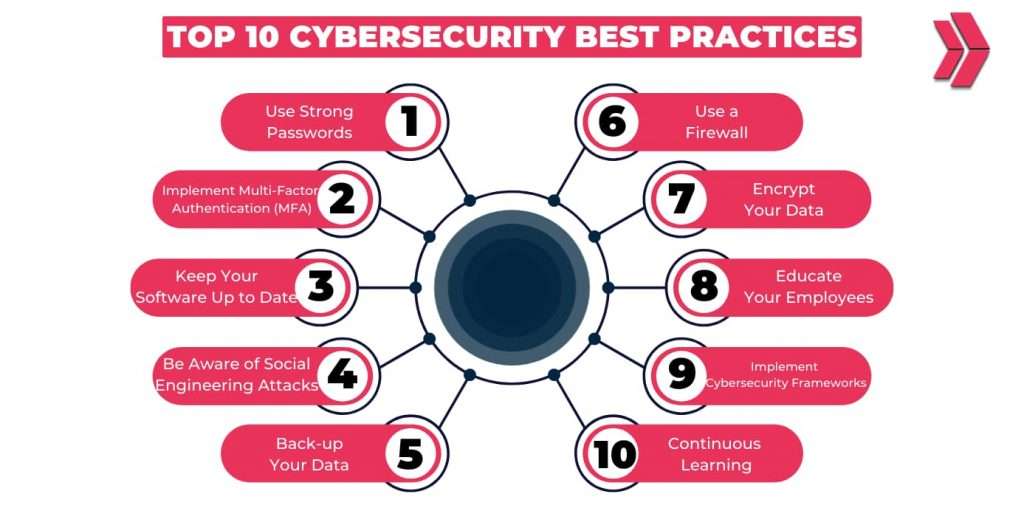
Seven Crucial Cybersecurity Best Practices
The digital landscape is increasingly complex and fraught with potential security risks․ From sophisticated phishing attacks to insidious malware, the threats to individuals and organizations alike are ever-present․ Maintaining robust cybersecurity practices is no longer a luxury; it’s an absolute necessity․ Ignoring these vital safeguards can lead to devastating consequences, including financial losses, reputational damage, and legal repercussions․ This article will delve into seven crucial best practices that can significantly bolster your cybersecurity posture․
1․ Strong and Unique Passwords: The Foundation of Security
The cornerstone of any effective cybersecurity strategy lies in strong, unique passwords․ Avoid easily guessable passwords like “password123” or your birthday․ Instead, opt for long, complex passwords that incorporate a mix of uppercase and lowercase letters, numbers, and symbols․ Consider using a password manager to generate and securely store these complex passwords, eliminating the need to remember them all․ Password managers offer a crucial layer of protection, ensuring that your passwords remain confidential and secure․
Regularly updating your passwords is equally important․ Change them every few months, or even more frequently if you suspect a security breach․ This simple act can significantly reduce your vulnerability to unauthorized access․ Implementing multi-factor authentication (MFA) wherever possible provides an additional layer of protection, requiring a second form of verification beyond just a password․
2․ Software Updates: Patching the Vulnerabilities
Keeping your software updated is paramount․ Software developers constantly release patches to address security vulnerabilities discovered in their products․ Failing to install these updates leaves your systems exposed to potential exploits, making them easy targets for malicious actors․ Enable automatic updates whenever possible to ensure that your software is always running the latest, most secure version․
This applies to everything from your operating system and applications to your antivirus software and web browser․ Regularly checking for and installing updates is a proactive measure that significantly minimizes your risk of falling victim to cyberattacks․ Staying informed about security bulletins and advisories can further enhance your protective measures․
3․ Beware of Phishing Scams: Recognizing and Avoiding Deception
Phishing attacks remain a prevalent threat, often employing deceptive emails or websites to trick users into revealing sensitive information like usernames, passwords, or credit card details․ Learn to recognize the red flags of phishing attempts, such as suspicious email addresses, grammatical errors, urgent or threatening language, and unexpected requests for personal information․
Never click on links or open attachments from unknown or untrusted sources․ If you’re unsure about the legitimacy of an email, contact the sender directly using a known and verified contact method to confirm its authenticity․ Regular employee training on phishing awareness is crucial in mitigating the risk of successful phishing attacks within an organization․
4․ Secure Your Wi-Fi Network: Protecting Your Home and Office Connectivity
Protecting your Wi-Fi network is crucial, especially in environments where multiple devices are connected․ Use a strong, unique password for your Wi-Fi network, and avoid using the default password provided by your router․ Enable WPA2 or WPA3 encryption for robust security․ Regularly check your router’s security settings and update its firmware to patch any known vulnerabilities․
Consider using a virtual private network (VPN) when connecting to public Wi-Fi networks, as these networks are often less secure and more susceptible to eavesdropping․ A VPN encrypts your internet traffic, protecting your data from prying eyes․ These simple steps can significantly enhance the security of your Wi-Fi network․
5․ Data Backup and Recovery: Safeguarding Against Data Loss
Regularly backing up your important data is essential to safeguarding against data loss due to hardware failure, malware infection, or natural disasters; Implement a robust backup strategy, using multiple backup methods and storing backups in different locations․ This ensures that you can recover your data even if one backup method fails․ Consider using cloud-based backup services for offsite storage, adding an additional layer of protection․
Regularly test your backups to ensure they are working correctly and that you can restore your data successfully․ This will prevent unexpected data loss and ensure business continuity in case of an emergency․ A well-defined recovery plan is crucial to minimize downtime and data loss in the event of a disaster․
6․ Antivirus and Anti-malware Software: Your First Line of Defense
Installing and maintaining up-to-date antivirus and anti-malware software is a fundamental cybersecurity practice․ These programs scan your system for malicious software, protecting against viruses, worms, Trojans, and other threats․ Ensure that your antivirus software is regularly updated to protect against the latest threats and that its real-time protection is enabled․
Consider using a multi-layered approach to security, combining antivirus software with other security tools like firewalls and intrusion detection systems․ Regularly scan your system for malware, even if you don’t suspect an infection, as a preventative measure․ Be cautious about downloading files from untrusted sources, as these files may contain malware․
7․ Security Awareness Training: Empowering Users to Protect Themselves
Educating users about cybersecurity best practices is critical․ Regular security awareness training can empower employees and individuals to recognize and avoid common threats, such as phishing scams and malicious websites․ This training should cover topics such as password security, phishing awareness, safe browsing habits, and social engineering tactics․
Training programs can include interactive modules, simulations, and real-world examples to make the learning process engaging and effective․ Regular refresher courses should be conducted to reinforce learning and address emerging threats․ A well-informed workforce is a more secure workforce․
- Implement strong password policies․
- Regularly update software and operating systems․
- Educate employees on phishing and social engineering tactics․
- Use robust antivirus and anti-malware software․
- Back up data regularly to multiple locations․
- Utilize multi-factor authentication wherever possible․
Implementing these seven crucial cybersecurity best practices will significantly enhance your ability to protect your systems and data from a wide range of threats․ By combining technological safeguards with user education and awareness, you can build a robust and resilient cybersecurity posture․ Remember that cybersecurity is an ongoing process, requiring constant vigilance and adaptation to the ever-evolving threat landscape․ Staying informed about the latest threats and best practices is essential to maintaining a strong security posture․ Continuous learning and proactive measures are key to staying ahead of potential attacks and ensuring the safety and integrity of your valuable data and systems․ Proactive security is far more effective than reactive damage control․ Prioritize these practices, and you’ll significantly reduce your risk in the digital world;



